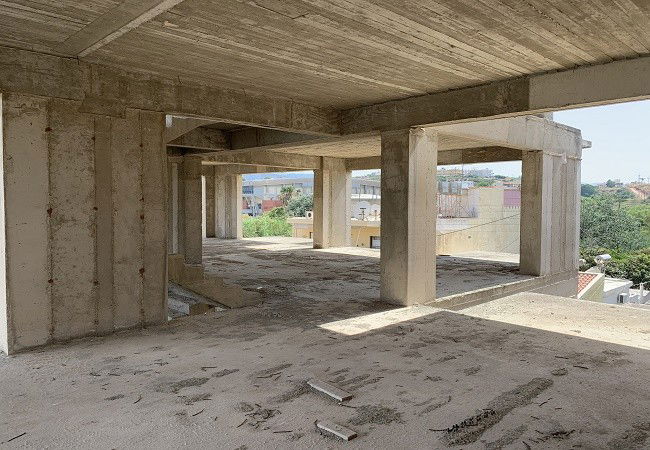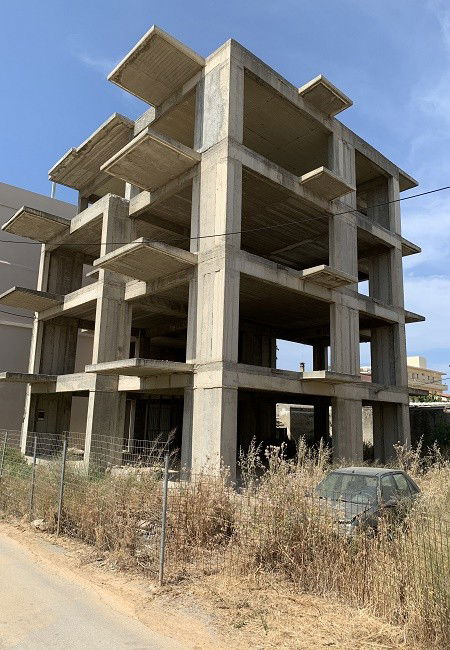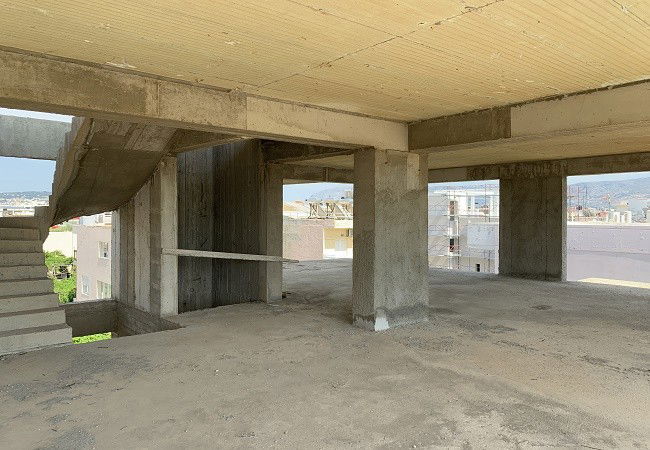
Building under construction for investment. Within a walking distance from the sandy beach of Nea Chora, the closest beach to the city center, there is an unfinished 677,67m² building with four floors and a building permit, ideal for investment. This property, when finished, can be used for long term rentals and for touristic use.
In a field of 620m², this four storey building has a ground floor is 92.81m² with parking spaces, the first and the second floor are 149.43m² and the third floor is 132m². The basement area is 154m². There is a building permit for four apartments in every floor.
This construction with all its current features and future potentials would make an ideal holiday house or permanent home. Don’t miss this opportunity as this property is ideal for investment in a very popular and touristic area!
In the area, there is a fine sandy beach along the waterfront and it is used a lot by locals and tourists for swimming during the summer.
There is also a lovely small harbour which enhances the feeling of the sea. This lovely four level property can become your new amazing project where the potentials owner preferences can be catered for in any way he wishes.
Location
The Municipal Market is an imposing and rather fine cross shaped building with doors on all four sides. It houses butchers and fishmongers, fruit and vegetable sellers and purveyors of a multitude of herbs and spices, as well as general wares. It is considered one of the finest indoor markets in Europe. To build it the central bastion of the city walls was demolished. It was inaugurated in 1913 as part of the celebrations of the unification of Crete with Greece.
Public Gardens - Situated between Papandreas and Tzanakaki streets the public gardens were designed by the Turks in 1870 to a European design. The clock was added between 1924 and 1927 with an unusual tripartite design. The gardens have a cafe, open air auditorium, small animal enclosure and a childrens library.
1866 Square and Environs - Surrounding this garden square youll find taxi ranks, also buses for short journeys west of Chania, ideal for the best local beaches. A few minutes walk north along Kydonias street and youll come across the KTEL bus station with its distinctive turquoise coloured buses. Buses leave fairly promptly on the half hour and the hour for destinations all over Crete.
Welcome to Chania, a beautiful and picturesque city with reminders of the past at every corner. Chania is the main town in the west of Crete, with the second largest population after Heraklion. It is divided into two parts - The New Town which is where the day to day business of the Chania goes on, with its shops and offices, the post office and banks, the renowned indoor market and the bus station, and the Old Town, built around the Venetian harbour with numerous picturesque narrow streets and architecture showing the influence of decades of foreign domination. Recent excavations have established that the ancient city of Kydonia was located here also. The first thing a visitor sees when reaching the town of Chania is the Venetian harbour and castle (Firka fort). This image of the town has remained unspoiled throughout the years, bringing back memories, when Chania was the governing capital of Crete and the independence of the island was declared.
The town of Chania will be the starting point, to familiarize you with the prefecture. The graphic seaside or mountainous villages have their own pace of life, the famous Samaria gorge, the steep White Mountains of Crete, the endless beaches of the Livikon Sea, the unspoiled seashores of Western Crete and the small islets make up this beautiful island. An island with wild, natural beauty, basking in sunlight and the blue sea captivates visitors from the first moment and guarantees further visits. Chania is the capital of the prefecture because of its geographic position and commercial activity. For many years was the governing centre of Crete and throughout history has been under Arab, Venetian and Turkish occupation. As a result, a blend of civilizations and unconquerable Cretan spirit make up this island.
The city dates back to the Neolithic period and recent archaeological digs on the acropolis of Kasteli have uncovered remains of a significant Minoan community. Known as Kydonia in the past it was one of the most important cities of Crete right up to the Arabian seizure in 824 AD. The Venetians purchased Crete in about 1204 but lost it to the Genoese between 1267 and 1290. The city of Chania was rebuilt on the site of the Byzantine acropolis in 1252 and after improving the fortifications at Kastelli the Venetians built their own cathedral plus many palaces and houses in the surrounding area for their people. In 1645, after a two month siege with terrible losses, the Turks overwhelmed the whole island. Chania became the Turkish island capital. Its churches were converted to mosques. Every new building is designed and constructed with Turkish rhythms and many constructions like baths (hamams) mosques are saved from those years. The Turks were expelled in 1898 when Prince George became the High Commissioner of Crete, though the actions of the Great Powers of Britain, France and Russia.
The official union of Crete with the rest of Greece, on December 13th, 1913, with the raising of the Greek flag on Firka fort, led to a cease in turmoil and hard oppression on the proud and brave Cretan people. This pride and bravery was last called on to fight against German occupation, when Chania was turned into a battlefield in 1941 (battle of Crete). With distinguished gallantry, the residents battled with the 3.500 German parachutists, in the area of Maleme (20km west of Chania). That same year, the town of Chania was bombarded, destroying the largest part of the Venetian citadel and eastern district of Splantzia.
Worth visiting:
The old town, around the Venetian harbour, where you can see many graphic homes and buildings from the Venetian period, giving the town a special atmosphere. It is also the centre of night-life with many bars and clubs. Dont forget to visit the lighthouse and Firkas fort where during the summer months, many theatrical performances and shows take place at the fort, which is also a naval museum.
Skridlof Street, where visitors can find a great selection of handmade leather goods. This area also called "Stivanadika".
The archaeological museum, on Halidon Street, has findings from all the prefecture of Chania.
The famous Municipal market of Chania "Agora" shaped in a cross, situated in Sofoklis Venizelos square.





 Building under construction for investment. Within a walking distance from the sandy beach of Nea Chora, the closest beach to the city center, there is an unfinished 677,67m² building with four floors and a building permit, ideal for investment. This property, when finished, can be used for long term rentals and for touristic use.
Building under construction for investment. Within a walking distance from the sandy beach of Nea Chora, the closest beach to the city center, there is an unfinished 677,67m² building with four floors and a building permit, ideal for investment. This property, when finished, can be used for long term rentals and for touristic use. Building under construction for investment. Within a walking distance from the sandy beach of Nea Chora, the closest beach to the city center, there is an unfinished 677,67m² building with four floors and a building permit, ideal for investment. This property, when finished, can be used for long term rentals and for touristic use.
Building under construction for investment. Within a walking distance from the sandy beach of Nea Chora, the closest beach to the city center, there is an unfinished 677,67m² building with four floors and a building permit, ideal for investment. This property, when finished, can be used for long term rentals and for touristic use.